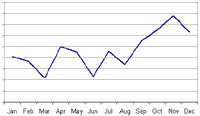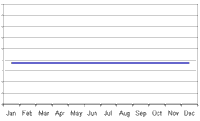In terms of dealing with data, many companies struggle with seasonal fluctuations.

Some of the most common seasonal fluctuations I’ve seen are due to:
- Holidays – like Christmas, Thanksgiving, Labor Day, etc.
- Hallmark Holidays – like Valentines day, Mother’s day, etc.
- Traditions – like New Year’s resolutions, etc.
- School-related events – like spring & summer breaks, football season, homecoming, proms, school year starts, graduations, reunions, etc.
- Actual Seasonal changes – like the coldness of winter, summer heat, rainy season, etc.
While some people see seasonality as the bane of their existence, I see it another way. For me…
SEASONALITY = OPPORTUNITY
The way I see it, the more complex something gets, the bigger the opportunity for those who are able to deal with it because the barrier to entry is high and the number of savvy companies that can figure out how to properly deal with it properly are low.
Why Seasonality is Difficult
Two primary reasons: 1) Seasonality mucks up data and 2) obtaining 3rd party seasonal data is not easy.
In the first case, companies that don’t learn to deal with it correctly will make poor decisions. Not realizing that Easter falls in March next year could cause you to mimic activity from this year 2-3 weeks late, but not realizing that Easter was the cause of your increased sales this year is an even bigger missed opportunity. Always pay attention to peaks and valleys for your site or sections of your site to better understand the human behavior that cause such a fluctuation. If you can figure out why, then you have a competitive advantage going into the next time that event may occur.
In the second case, sure there is Google Trends if you know in advance what terms to look at (which is not usually the case), but if you were to jump into Google Adwords or any keyword tool wanting to know what will be a hit two or three months into the future, you can’t rely on average data or what happened last month. I’ve found great value in services like Hitwise (though very expensive) where I can look at keyword trending over time and see what keywords drove traffic to my competitors 13 months ago.
How to Deal With Seasonality
To best tackle seasonality, mine your data and mine external industry data. Look for monthly, weekly and even daily fluctuations. Keep tabs on w/w, m/m and y/y growth rates. Also, keep a calendar of events that may cause fluctuations in data (site redesign), so you don’t mistakenly attribute that fluctuation to something else. And when you can identify a source for the seasonality, make an action plan for next year.
Understanding your seasonality is the first part. Acting upon the intelligence is the second. For example, if a weight loss company discovers that summer high school reunions cause a burst of new customers in June, target your late May to June advertising to reunion planning sites like facebook, classmates, yahoo groups, reunions.com or bidding on long-tail local reunion terms like “ehs 2007 reunion” (note: not a single advertiser has figured this one out yet) or “roosevelt high school 1994 class reunion”. Even consider creating a special plan targeted to those customers (Rapid Reunion Weight-Loss Program).
To be fair, many companies, especially retail, have seasonality built into their veins, but even these types of companies could easily improve if they understood what exactly is driving people’s interest and the exact timing of it.
If you are in a business affected by seasonality, be happy that your data has a pulse:

instead of a a flat line like this (call life support, we’ve got a flatliner):

For those fascinated by seasonality, I recommend reading Click by Bill Tancer.
For more false-seasonality fun, read: Days in the Month Bias for Analytics

